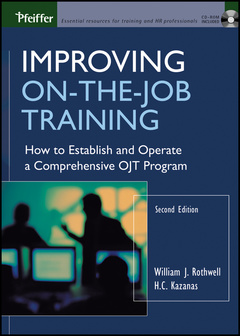Description
Improving On-the-Job Training (2nd Ed.)
How to Establish and Operate a Comprehensive OJT Program
Authors: Rothwell William J., Kazanas H. C.
Language: English
Subject for Improving On-the-Job Training:
Approximative price 69.88 €
In Print (Delivery period: 12 days).
Add to cart
Publication date: 07-2013
208 p. · 18x25.5 cm · Paperback
208 p. · 18x25.5 cm · Paperback
Description
/li>Contents
/li>
This second edition of the best–selling book, Improving On–The–Job Training , provides professional trainers, HR managers, and line managers with a hands–on resource for installing a low–cost, low tech approach to planned on–the–job training program that will improve real–time work performance throughout an entire organization. A comprehensive volume, Improving On–The–Job Training Offers guidelines for establishing an OJT program. Outlines the key management issues that should be addressed when starting up a program. Describes effective methods of training the trainers and learners. Shows how to identify the need for planned on–the–job–training. Explains how to analyze work, worker, and workplace OJT. Offers vital information for preparing and presenting on–the–job training. Illustrates how to evaluate results of OJT. Describes aids to planned on–the–job training. Includes six valuable lessons about planned OJT programs.
List of Tables, Figures, and Exhibits xi Introduction: Getting the Most From This Resource xiv Why Improve OTJ? xv Purpose xvii Overview of the Contents xvii Pretest: Does Your Organization Need a Planned On–the–Job Training Program? xix The Pretest xix Scoring and Interpreting the Pretest xxi PART ONE: FOUNDATIONS OF OJT: Building an Effective Organizational Climate to Support OJT 1 1 The Benefits of Effective On–the–Job Training 3 Unplanned OJT: A Case Study 4 Importance of OJT 5 Coaching, Mentoring, and OJT 7 A Short History of Planned OJT 8 Research on Planned OJT 9 Barriers to OJT 11 Surmounting Barriers to OJT 12 Summary 13 2 Building the Right Foundation: From Identifying Goals to Establishing an Action Plan 14 Determine Program Purpose 14 Clarify Program Goals and Objectives 17 Identify Program Customers 18 Formulate Program Policy and Philosophy 19 Develop Program Action Plan and Schedule 10 Summary 20 3 Ensuring Sound Management and Consistent Results 21 Oversight Responsibility 21 Rewards and Incentives 23 Budgeting and Funding 25 Record Keeping 26 Summary 27 4 Preparing Trainers and Learners 28 Training the Trainers 28 Training the Learners 35 Summary 41 PART TWO: PREPARING AND DELIVERING OJT 43 5 Discovering Needs: How to Determine When OJT Is Appropriate 45 The DAPPER Model 45 Questions That Determine OJT Needs 46 Summary 57 6 Analyzing Work, Worker, and Workplace: How to Fit the Training to the Job 59 Work Analysis 59 Worker Analysis 69 Workplace Analysis 74 Summary 74 7 Preparing the Training Plan: How to Develop the Right Sequence of Activities 76 Steps for Preparing OJT 76 Designing Instructional Materials 80 Summary 93 8 Presenting the Training: How to Conduct the OJT Session 96 Desirable Characteristics of Trainers and Learners 96 Steps Governing OJT Presentation 98 Summary 102 9 Evaluating Results: How to Assess Post–Training Job Performance 104 OJT and Kirkpatrick&rsquo,s Levels of Evaluation 104 Level 1: Evaluating Reactions 105 Level 2: Evaluating Learning 108 Level 3: Evaluating Behavioral Change 111 Level 4: Evaluating Organizational Results 114 OJT and the Balanced Scorecard 118 Summary 118 10 Reviewing Aids and Alternatives to OJT: How to Ensure the Right Mix of Performance Interventions 119 Determining Whether an Aid or Alternative Is Needed 119 Aids to OJT 120 Additional Tools to Support OJT 128 Researching Corporate Culture–Specific Competency Development Strategies 134 Summary 139 PART THREE: REFLECTIONS ON OJT 141 11 Six Important Success Factors for Comprehensive OJT Programs 143 Success Factor 1: Avoid Discrimination in OJT 143 Success Factor 2: Enlist the Participation of Key People 144 Success Factor 3: Encourage the Preparation of Current Job Descriptions&mdash,But Plan for the Future 145 Success Factor 4: Integrate Internship, Cooperative Education, and Apprenticeship Programs with OJT 145 Success Factor 5: Establish Measurable Job Performance Standards and Objectives and Link Them to OJT 148 Success Factor 6: Plan for Cross–Training and Multiskilling 149 Glossary 153 References 156 About the Authors 167 Index 169 Pfeiffer Publications Guide 179
© 2024 LAVOISIER S.A.S.




